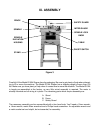
- 5 -
5. KEEP WORK AREA CLEAN. Cluttered areas and benches invite accidents.
6. AVOID DANGEROUS ENVIRONMENTS. Do not use power tools in damp or wet locations or
expose them to rain. Keep your work area well lighted.
7. KEEP CHILDREN AND VISITORS AWAY. All children and visitors should be kept a safe dis-
tance away from your work area.
8. MAKE WORKSHOP CHILD-PROOF with padlocks, master switches, or by removing starter
keys.
9. DO NOT FORCE TOOL. Tools work better and more safely when they are allowed to work at
their own speed.
10. USE THE RIGHT TOOL. Do not use a tool or an attachment to do a job it wasn’t intended for.
11. WEAR PROPER APPAREL. Do not wear loose clothing, gloves, neckties, or jewelry that might
get caught in moving parts. Non-slip footwear is also recommended. Wear a hat or other pro-
tective head wear if your hair is long.
12. USE SAFETY GLASSES AND EAR PROTECTION. Also use a dust mask if the cutting oper-
ation is dusty.
13. SECURE YOUR WORK. Use clamps or a fixture to hold your work. It is safer than using your
hands and frees up both hands for operating the tool.
14. DO NOT OVERREACH. Keep proper footing and balance at all times.
15. MAINTAIN TOOLS IN TOP CONDITION. Keep tools sharp and clean for best and safest per-
formance. Follow instructions for lubricating and changing accessories.
16. DISCONNECT TOOLS FROM POWER before servicing and when changing accessories, such
as blades, bits and cutters.
17. USE RECOMMENDED ACCESSORIES. Consult the current catalog for recommended acces-
sories. The use of improper accessories may be hazardous.
18. AVOID ACCIDENTAL STARTING. Make sure the switch is in the “OFF” position before plug-
ging in the cord.
19. NEVER STAND OR LEAN ON TOOL. Serious injury could occur if the tool is tipped or if the
cutting tool is accidentally contacted.
20. CHECK DAMAGED PARTS. Before further use of the tool, any part or guard that is damaged
should be promptly repaired or replaced. Do not operate the machine until you are certain it is
in perfect running condition. Failure to follow this precaution could result in further mechanical
damage and operator injury.
21. DIRECTION OF FEED. Always feed your work against the direction of blade or cutter travel.
Workpieces fed in the same direction as the cutter travel could be forced out of your control.


















